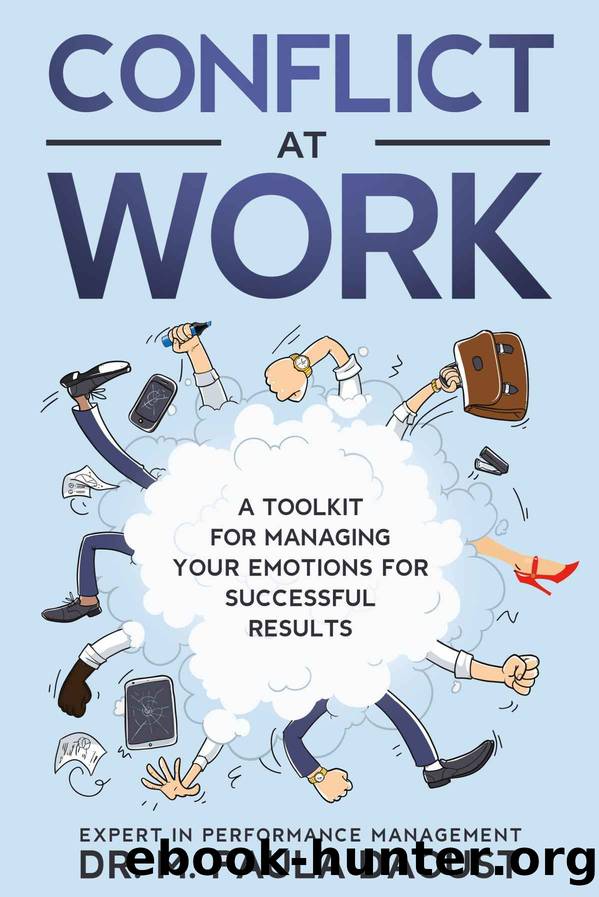Conflict at Work: A toolkit for managing your emotions for successful results. (Resolving Conflict Book 1) by M Paula Daoust

Author:M Paula Daoust [Daoust, M Paula]
Language: eng
Format: azw3
Publisher: Maplewheat Publishing
Published: 2020-09-01T00:00:00+00:00
asking open-ended questions; and, finally,
asking more questions based on the answers you get.
Making these four steps part of your natural response to tension with another party will take practice but itâs worth the effort. From my experience in coaching managers, so many disputes could have been avoided or minimized if they had checked their understanding of the other partyâs communication or had clarified their own.
Language patterns
Language is a big deal and we often underestimate the impact of our choice of words and phrases. While you were growing up, certain words word or phrases were used frequently within specific contexts. This frequent pairing conditioned you to respond to these words and phrases with a predictable reaction. Some evoke a positive response; others, a negative one. I call these magic words and phrases because they are producing a consistent response although you are usually not consciously aware of the impact which they are having on your emotions.
Words and phrases that create a positive, energizing effect I refer to as sparks. Those words that have the opposite effect of either provoking you to shut down and withdraw mentally from the conversation or which create anger, frustration, or a sense of victimization, I refer to as triggers. Everyone has their own mix of sparks and triggers, depending on their experience. There are, however, many sparks and triggers that are common to most people raised in a Western culture and it is worth identifying them.
Trigger words and phrases are a problem in tense situations because, without realizing it, we are more likely to use them during these discussions. When we do, we increase the sense of threat in the other person and thus make the situation even more difficult. We tend to use these words and phrases when we feel some level of threat because they make us feel like we have more control. Unfortunately, they have the opposite effect because they provoke the other party to increase their own resistance to us.
Some examples of the most common triggers and sparks and how they work are described below, but these lists certainly do not include all possible examples. Depending on your experience, some words would have a bigger impact than others on you personally. There are some triggers and sparks that are truly unique to you and are not listed here. After reviewing this list of common triggers and sparks, it might be useful to take some time to think about which words or phrases serve as a trigger or spark for you. It would also be useful to watch for when and where you are using the common triggers and sparks and to notice what response you are getting from the other party.
Trigger words and phrases
How and why they provoke increased resistance
Download
This site does not store any files on its server. We only index and link to content provided by other sites. Please contact the content providers to delete copyright contents if any and email us, we'll remove relevant links or contents immediately.
Harry Potter and the Goblet Of Fire by J.K. Rowling(3038)
Never by Ken Follett(2878)
Shadow of Night by Deborah Harkness(2716)
Ogilvy on Advertising by David Ogilvy(2682)
Zero to IPO: Over $1 Trillion of Actionable Advice from the World's Most Successful Entrepreneurs by Frederic Kerrest(2387)
The Man Who Died Twice by Richard Osman(2293)
Machine Learning at Scale with H2O by Gregory Keys | David Whiting(2281)
Book of Life by Deborah Harkness(2263)
How Proust Can Change Your Life by Alain De Botton(2259)
My Brilliant Friend by Elena Ferrante(2221)
0041152001443424520 .pdf by Unknown(2218)
The Tipping Point by Malcolm Gladwell(2204)
How to Pay Zero Taxes, 2018 by Jeff A. Schnepper(2098)
Will by Will Smith(2039)
Purple Hibiscus by Chimamanda Ngozi Adichie(1981)
Hooked: A Dark, Contemporary Romance (Never After Series) by Emily McIntire(1945)
Borders by unknow(1785)
Rationality by Steven Pinker(1763)
Daughter of Smoke and Bone by Laini Taylor(1742)
